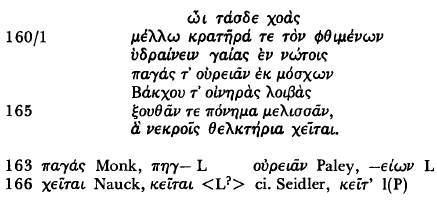No CrossRef data available.
Article contents
Notes on the Iphigenia in Tauris of Euripides1
Published online by Cambridge University Press: 28 February 2013
Extract

In 162 read  for
for  . The sphere of reference of the verb
. The sphere of reference of the verb  is confined to water: 54
is confined to water: 54  (Musgrave,
(Musgrave,  L)
L)  (a reference to the ritual
(a reference to the ritual  : see Denniston on El. 791), El. 157
: see Denniston on El. 791), El. 157  (cf.
(cf.  ‘having washed’, Hom. Od. 4.750, 759, 17.48, 58).
‘having washed’, Hom. Od. 4.750, 759, 17.48, 58).
- Type
- Research Article
- Information
- Copyright
- Copyright © The Author(s). Published online by Cambridge University Press 1976
References
NOTES
2. In 872 a final resolved syllable is divided between two words. Since there are parallels for this division (Parker, L.P.E., CQ n.s. 18 (1968) 267)CrossRefGoogle Scholar, Weil's transposition of ![]() before
before ![]() is unnecessary.
is unnecessary.
3. The lyric metres of Greek drama ed. 2 (Cambridge 1968) 114Google Scholar.
4. Hermes 92 (1964) 39Google Scholar.
5. One alleged instance in dochmiacs which he quotes (see also Fraenkel, , Agamemnon p. 827Google Scholar, Barrett, on Hi. 760Google Scholar) is Soph., El. 853Google Scholar![]() , where we might remove the anomaly by writing
, where we might remove the anomaly by writing ![]() , an expression formed in the same mould as Hom., Il. 10.250Google Scholar
, an expression formed in the same mould as Hom., Il. 10.250Google Scholar![]()
![]() , Pi., Pyth. 4.142Google Scholar
, Pi., Pyth. 4.142Google Scholar![]() , Aesch., Ag. 39Google Scholar
, Aesch., Ag. 39Google Scholar![]() , Soph., Ai. 543Google Scholar
, Soph., Ai. 543Google Scholar![]() ;, Eur., HF 1185Google Scholar
;, Eur., HF 1185Google Scholar![]() . Cf. Jebb on Soph. OC 1539Google Scholar, Bruhn, , Anhang § 251Google Scholar. The corruption of
. Cf. Jebb on Soph. OC 1539Google Scholar, Bruhn, , Anhang § 251Google Scholar. The corruption of ![]() to
to ![]() is nothing out of the ordinary:
is nothing out of the ordinary: ![]() is corrupted to
is corrupted to ![]() at IT 150, IA 218
at IT 150, IA 218 ![]() to
to ![]() – at IA 592,
– at IA 592, ![]() to– at Aesch., Eum. 142Google Scholar.
to– at Aesch., Eum. 142Google Scholar.
6. See Page, D.L., A new chapter in the history of Greek tragedy (Cambridge 1951) 44 n.25Google Scholar, and Denniston and Page on Aesch., Ag. 536Google Scholar.
7. Passages like ![]() (IT 3)are not relevant here.
(IT 3)are not relevant here.
8. Monk's objection, that ‘it is not the practice, when the genitive depends on an adjective, to add to it another epithet’, is answered by Hi. 811 ![]() .
.
9. See Breitenbach, W., Untersuchungen zur Sprache der Euripideischen Lyrik (Stuttgart 1934) 217–21Google Scholar.
10. Euripidis cantica (Leipzig 1910) 102Google Scholar.
11. Possibly the verb was similarly used at Soph. fr. 211.11 P (I. fr. 6.11 Carden, , Pap. fragments of Soph. (Berlin 1974)CrossRefGoogle Scholar![]() .
.
12. Wetklein and others ascribe Hermann's ![]() and
and ![]() to Bothe. This is incorrect, since the conjectures first appeared in Seidler's edition, which preceded Bothe's by thirteen years.
to Bothe. This is incorrect, since the conjectures first appeared in Seidler's edition, which preceded Bothe's by thirteen years.
13. Wilamowitz, , Griechische Verskunst 268Google Scholar, compares Hec. 1099Google Scholar, a trochaic dimeter after dochmiacs.
14. But Platnauer should not have found fault with the word-order: cf. 1168 ![]() ; and Thomson, G., CQ 33 (1939) 147–52CrossRefGoogle Scholar.
; and Thomson, G., CQ 33 (1939) 147–52CrossRefGoogle Scholar.
15. Jahrb.f.cl.Phil. 10 (1864) 233–4Google Scholar.
16. R.Phil. n.s. 2(1878) 49Google Scholar.
17. In 877 ![]() is sound: see 464, 595, 1209, 1214. Proposals for its replacement (several may be found in Wecklein) are unnecessary or worse.
is sound: see 464, 595, 1209, 1214. Proposals for its replacement (several may be found in Wecklein) are unnecessary or worse.


